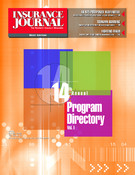Nearly Half of Large, Mid-sized Businesses Purchased Terrorism Insurance in 2004
Nearly half of large and mid-sized U.S. businesses obtained insurance to cover property terrorism risks during 2004, a dramatic increase from the 2003 average of 27 percent. Meanwhile, the cost of property terrorism insurance in 2004 was unchanged from 2003, indicating that the higher purchasing rate was not driven solely by price.
A new report from Marsh Inc., based on data compiled from 2,371 businesses and government entities that purchased or renewed property insurance policies in 2004, finds the purchase of property terrorism insurance in 2004 varied significantly, depending on a company’s total insured values and location. Notably, smaller companies (those with total insured values less than $100 million) were much less likely to purchase this coverage.
Take-up rates-the percentage of companies buying the coverage-varied considerably by region: about 53 percent of firms in the U.S. Northeast and Midwest purchased property terrorism insurance in 2004, compared with 47 percent in the South, and 34 percent in the West.
Among firms in major cities, take-up rates were the highest for those located in Boston, where 69 percent of businesses purchased property terrorism coverage; followed by Washington, D.C. (60 percent); Chicago (58 percent); Dallas (57 percent), and New York City (54 percent). Of 10 major metropolitan areas examined in the study, the rates for property terrorism insurance were highest in Washington, DC (0.0112 percent), followed by New York City (0.0107 percent) and Houston (0.0083 percent).
On the West Coast, only 39 percent of Los Angeles businesses and 37 percent of those in San Francisco purchased terrorism insurance even though rates for coverage in those cities were significantly lower than in many other cities-0.0072 percent and 0.0038 percent, respectively.
“Clearly, several factors can influence a company’s decision to purchase property terrorism insurance,” said Stephen Lundin, a managing director in Marsh’s Property Practice. “In addition to considering the pricing of property terrorism insurance and its terms, many businesses are making decisions based upon their perception of risk.”
Surprisingly, despite what some consider elevated risks associated with the energy industry, fewer than one in four (23 percent) businesses in Houston purchased terrorism insurance in 2004.
Within specific industrial sectors, financial institutions, real-estate firms, and health-care facilities had the highest overall take-up rates, each exceeding 60 percent.
Take-up rates also varied dramatically by overall insured property values. Firms with total insured values of $500 million to $1 billion had the highest take-up rate, 57 percent. Next were firms with total insured values of $1 billion or more (53 percent), followed by those with $100 million – $500 million (50 percent). About 35 percent of the firms with total insured values under $100 million purchased property terrorism insurance in 2004. Nonetheless, the take-up rates for all-sized businesses were dramatically higher in 2004 than in 2003.
In the aftermath of Sept. 11, 2001, insurance companies excluded terrorism risks from their commercial policies. The Terrorism Insurance Act, signed into law by President Bush in November 2002, requires insurance companies to offer insurance for certain acts of terrorism in the U.S. that are “certified” by the Secretary of the U.S. Treasury Department, the Secretary of State and the Attorney General. The terrorism coverage offered to insurance buyers under TRIA must be in amounts and have terms and conditions that do not differ materially from their other policies.
In addition, as a complement to certified TRIA coverage, insurers are offering “non-certified” coverage, which includes coverage for terrorism risks outside the U.S. as well as terrorism in the U.S. arising from indigenous acts. In 2004, 70 percent of companies that purchased property terrorism insurance bought a combination of TRIA and non-certified coverage.
As a third alternative, businesses can purchase separate, “stand-alone” terrorism insurance policies that are outside of their property insurance programs and do not require U.S. government certification.
According to Marsh’s report, capacity in the stand-alone property terrorism insurance market is relatively stable, though limited. The amount available for a specific “Since its enactment, TRIA has helped stabilize the terrorism insurance market, making coverage for this risk more available and affordable,” Lundin said. Unless TRIA is extended, it will expire at midnight, Dec. 31, 2005.
“If TRIA is not extended, the stand-alone insurance market is unlikely to have sufficient capacity to satisfy all of the expected demand at commercially viable prices,” Lundin cautioned. “Further, under those circumstances it’s unrealistic to expect insurers to maintain their present terrorism capacity or to expect the reinsurance market to fill the void.”
Topics Catastrophe USA Property Market
Was this article valuable?
Here are more articles you may enjoy.


 Alliant Latest to Sue Howden US Over Alleged ‘Smash-and-Grab’ Poaching
Alliant Latest to Sue Howden US Over Alleged ‘Smash-and-Grab’ Poaching  New York Governor Hochul Vows to Tackle Insurance Affordability, Litigation and Fraud
New York Governor Hochul Vows to Tackle Insurance Affordability, Litigation and Fraud  Wildfires, Storms Fuel 2025 Insured Losses of $108 Billion: Munich Re Report
Wildfires, Storms Fuel 2025 Insured Losses of $108 Billion: Munich Re Report  Warburg Mulls $1 Billion Sale of London Insurance Broker McGill
Warburg Mulls $1 Billion Sale of London Insurance Broker McGill 


